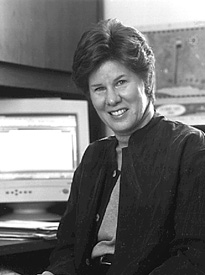

 |
 |
|
||
| Research |
Michele Forman, Ph.D.
|
|
 |
Basic Research Laboratory | ||||||||||||||||||
 |
|
|||||||||||||||||||
| In 1977, Dr. Forman received her Ph.D. for studies in nutritional epidemiology at the University of North Carolina, Chapel Hill. Dr. Forman first came to the NIH in 1976 as an epidemiologist in the National Institute of Child Health and Human Development, then spent 3 years at the Centers for Disease Control in the Nutrition Division. In 1986, she joined as an associate professor at Johns Hopkins University School of Hygiene. In 1989, she returned to the NIH, where she is now a senior investigator in the NCIís Basic Research Laboratory. | ||||||||||||||||||||
|
Research
|
||||||||||||||||||||
| The Role of Early Life Events and Nutritional Status in Reproductive Cancers in Women and in Childhood Cancers
A womanís lifetime exposures to hormones are thought to increase her risk of breast and other reproductive cancers. Epidemiological studies have primarily focused on reproductive risk factors as indicators of adult hormonal status. More recently, research has turned to hormonal and other exposures in the fetal environment, since exposures to hormones in utero are 10-fold higher than in infancy and early childhood. Dr. Formanís research focuses on the effect of birth weight, maternal complications during pregnancy such as preeclampsia, and other perinatal factors as indicators of hormonal exposures in early life of the risk of adult reproductive cancers in offspring. This research, known as the Motherís Study, is being conducted as part of a collaboration with the Nursesí Health Studies at the Harvard School of Public Health, with Dr. Forman and Dr. Walter Willett of Harvard University as the principal investigators. The cohort includes over 100,000 nurse daughters who are currently free of chronic disease and who are being followed to ascertain incident diagnoses of cancer. The mothers of the nurse daughters are asked to report information about early life exposures including in utero, infant, and early childhood events and practices that might be related (potentially by hormonal, nutritional, and metabolic programming) to risk of adult cancers. The Motherís Study has a retrospective component from the mothers and a prospective followup of their offspring and forms the first prospective cohort study in this field. Currently maternal responses to questionnaires that are either self-administered by the mother or completed with the nurse daughter are being analyzed in relation to body mass index in childhood and adulthood, age at menarche and other recognized risk factors for cancer and other chronic disease, while the nurse daughters of ill or deceased mothers are providing information on early life exposurescollected within biannual followup of each Nursesí Health Study cohort. In collaboration with Norwegian investigators, Dr. Forman is following offspring of preeclamptic pregnancies to test whether these offspring delay puberty compared with offspring of normotensive pregnancies. Information about pubertal growth and development may help to explain why preeclamptics and their offspring are at reduced risk of hormone-related cancers compared with normotensive women and their offspring. In collaboration with Drs. Linet and Wacholder of NCIís Division of Cancer Epidemiology and Genetics, Dr. Forman is involved in examining the relation of infant feeding practices to risk of childhood cancer in a case-control study and in examining whether timing of the maternal interview, after diagnosis of a child with cancer, influences the direction and magnitude of maternal reporting of exposures that are currently associated with risk of childhood cancer. The latter study is being piloted and is planned for initial data collection in the late fall of 2001. Human papillomavirus (HPV) infections are considered the major etiologic risk factor for the development of cervical intraepithelial neoplasia and for invasive cervical cancer. HPV is a transient acute infection in many women, but in others the DNA of the virus becomes integrated into cellular DNA, thereby increasing the risk of developing cancer. As the persistent virus interacts with various host factors, such as immune response, the infection may directly cause cellular and chromosomal damage and the lesion may progress, accumulate additional genetic alterations, and ultimately become invasive. There is an array of HPV cancer-related subtypes because they are associated with increased risk of cervical cancer. As part of a collaboration with colleagues at CICAMS in China and in The Cleveland Clinic, Dr. Forman is examining the relation of vitamin A status and history of bacterial vaginosis to risk of cervical cancer in women. Bacterial vaginosis, like HPV, commonly occurs in women in their twenties and is a transient acute infection that can be treated with antibiotics; however, some women are not responsive to therapy and develop chronic bacterial vaginosis. This condition is associated with alteration of the vaginal environment from an aerobic to anaerobic state, induction of nitrosamine formation, immunological changes, and increased prostaglandin concentrations. Vitamin A, which is indicated by tissue levels of vitamin A and their provitamin A carotenoid precursors, is responsible for epithelial cell proliferation, differentiation, immunological changes, and activation of receptors in cervical cancer. Dr. Forman is examining whether the presence of chronic vaginosis and low levels of vitamin A are associated with increased risk of cervical cancer in a group of women with HPV cancer-related subtypes in a pilot of 1,500 women in Shanxi Province, China. Dr. Forman is currently collaborating with members of the Polyp Prevention Trial to examine the relation of serum carotenoid levels to risk of polyp recurrence, the relation of changes in dietary practices to changes in serum carotenoid levels over time, and the analysis of the components of variation in serum carotenoid levels in this population. Our collaborators are Paul Albert, Barry Graubard, Elaine Lanza, Martha Linet, Luke Ratnasinghe, Susan Steck-Scott, Philip Taylor, and Sholom Wacholder, NIH; Graham Colditz, Karin Michels, and Walter Willett, Harvard University, Boston; and You-lin Qiao and Shu-Xiang Yao, Tin Mine Corporation and CICAMS, China. |
||||||||||||||||||||
| This page was last updated on 5/17/2004. | ||||||||||||||||||||

|
||